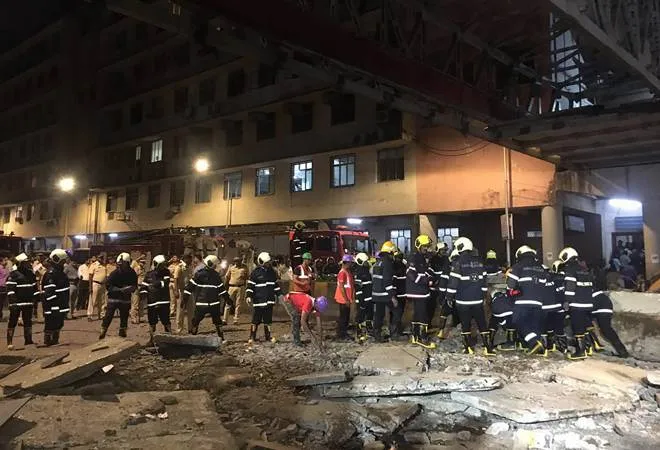-
CENTRES
Progammes & Centres
Location

At the end of a day’s work, on 14 March 2019, Mumbai’s workforce, as usual, was rushing to catch a train or a bus to reach home. As some of them sped towards the Chhatrapati Shivaji Maharaj Terminus (CSMT) via a foot overbridge to board the local trains, avoiding the heavy traffic on the road beneath, part of the bridge came crashing down on the road below. Life was snuffed out of six crushed men and women and 30 others suffered injuries. Part of the foot overbridge that had not collapsed was subsequently pulled down. Less than a year ago, in July 2018 another overbridge in Andheri, a suburb of Mumbai, had witnessed a similar collapse post heavy rains, killing two men.
Post the collapse of the foot overbridge at Andheri, the Municipal Corporation of Greater Mumbai (MCGM) had ordered the audit of 296 structures that included bridges, foot overbridges and railway overbridges. Auditors had reported that out of the lot, 110 were in good condition, 107 required minor repairs and 61 were in need of major refurbishment. Demolition and reconstruction was recommended for 18 other structures. The collapsed foot overbridge in question had also been audited.
Information collected reveals that this footbridge was constructed in 1984-86 and its audit was carried out in December 2016. Tests required for conditional assessment of the bridge were undertaken in July 2017 and a final report was submitted to MCGM in August 2018. The Structural Auditor reported that the bridge was in good condition and any impending failures of structural members of the overbridge were not foreseen. While the structural report recommended minor repairs, the nature and location of repairs were not defined.
The preliminary report of the MCGM has concluded that the structural report “appears to have completely overlooked the critical elements of the bridge and their condition leading to this sad tragedy. In spite of commissioning the structural audit report of the bridge and spending public money on it, the true condition of the bridge was not brought out.”
Following the preliminary report, the Structural Auditor has been arrested by the Mumbai Police. The Executive Engineer and the Assistant Engineer of the MCGM, who were charged with the responsibility of supervising the audit, have been put under suspension and enquiries have been launched against the Chief Engineer and the Deputy Chief Engineer. A show cause notice has been issued to the structural audit firm prior to its blacklisting.
The tragic incident has led the MCGM to look for a suitable candidate to be appointed as a “full-fledged Chief Bridge Inspector”, especially since the urban local body has 374 bridges and their number is growing. The Inspector shall head the Bridge Inspection Authority that would be tasked, inter alia, to do the following:
As is witnessed after each such civic tragedy, the mishap at CSTM resulted in public outcry. The media wanted heads in the civic body to roll. Such anger in a sense is natural, for the errors are grave and they smell of callousness and malfeasance of a very high order. However, those are the reasons that appear on the surface and prevent us from looking into the deep and wide malaise that has set in over time in municipal functioning. If they are not fixed, many more such civic mishaps would continue to happen with increasing regularity and things will not be set right despite meeting out exemplary punishment to civic employees. The three most critical maladies relate to governance, finance and capacity of municipal functionaries.
The first vital area yearning for radical reform is urban governance. Our cities run on a governance system that makes it impossible to fix responsibility on any one arm of the urban local body.
While the Municipal Commissioner is the chief executive, most financial approvals lie with the Standing Committee. Additionally, state functionaries play a vital role in a city’s decision making. Many other power centres operate behind the scene. They emanate from political parties and cast a shadow on municipal decision-making through blackmail and transfers. Unless an empowered Mayor is brought into the system with the sole and final decision-making authority, along with other instruments of good governance, accountability will remain a chimera to be talked about in debates, workshops and seminars.
The second point of pivotal significance is the issue of finance. Our cities have huge functional mandates but are among the most malnourished ULBs in the world.
Our calculation roughly shows that cities have on an average a mere one-third of the resources for decent implementation of their wide mandates at nationally-benchmarked standards. In the given situation, ULBs are unable to add new infrastructure and at the same time maintain the ones that already exist. This prevailing state operates even in the so-called richest city government of Mumbai. Its richness, or more accurately poverty, has to be gauged in terms of its budget, its large geographical area, its massive and ever-rising population, its huge mandated functions and the per capita revenue for each function. The results are staggeringly low. As a consequence, stress gets laid on expanding infrastructure through freshly needed works and the sad neglect of maintenance. It is obvious that maintenance requires a certain percent of asset cost every year to be spent on the asset’s upkeep. Defaulting on this, year after year, sets the ULB walking on a dangerous road as repeated incidents in cities across the country tellingly demonstrate.
The third vital area is the capacity building of all ULB personnel, but especially of municipal engineers, since they are the most critical functionaries in the municipal system. Municipal engineering jobs in our country are among the least sought after.
Private sector careers, public sector positions, central and state governmental jobs take precedence among the youth in this country. Poor quality intake in municipalities is further compromised by the system of transfers, purportedly to prevent the growth of vested interest and malfeasance. Every engineer in the system is rotated every few years into different departments – roads, regulation, development plan, water, waste and so forth. This does not seem to help prevent vested interest and corruption. But an emphatic result is that no expertise by any of the engineers is gathered in any municipal engineering area. However, engineering is not a generalist’s job. In the absence of in-house expertise, municipal engineers must outsource every job that requires specialised knowledge. Hence, there is a proliferation of consultants of all hue in the corridors of the MCGM.
A larger question, of course, marks the overall education system. Barring elite educational institutions, the average educational apparatus has been generally dehydrated of educational quality, giving the country alarming results in terms of professional merit of products. Clearly, there are dangerous signs on the horizon. In these disquieting circumstances, India is destined to urbanise in chaos and dysfunction if the fundamental problems facing the ULBs continue to be pushed under the carpet.
The views expressed above belong to the author(s). ORF research and analyses now available on Telegram! Click here to access our curated content — blogs, longforms and interviews.

Dr. Ramanath Jha is Distinguished Fellow at Observer Research Foundation, Mumbai. He works on urbanisation — urban sustainability, urban governance and urban planning. Dr. Jha belongs ...
Read More +